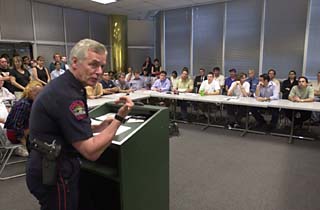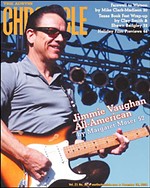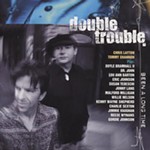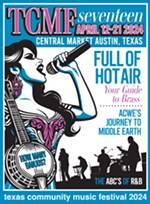Keeping the Peace
Round one of trying to establish a new city noise ordinance for Austin music
By Andy Langer, Fri., May 3, 2002

Nobody could have imagined that seven days of intense public debate over the city's proposed new noise ordinance would end in five minutes of silence.
And yet it was pin-drop quiet at last Wednesday's public forum on said noise ordinance, when Assistant Police Chief James Fealy used his closing comments to announce that the city wouldn't be moving forward with what he admitted was a "half-baked" proposal.
"We need to slow it down and back it up," Fealy told a standing-room-only crowd of club owners and local music industry players, who had just spent an hour outlining for APD representatives how the ordinance would destroy their livelihoods. Had Fealy begun the meeting with that announcement, those same concert promoters could have shifted their stance from fear and unbridled anger to hope and talk of compromise 55 minutes earlier.
Fealy's comments came exactly one week after the April 17 unveiling of an amendment to Austin's amplified sound ordinance that would have reduced the legal definition of "noise" from 85 decibels to 75dB. From the moment the proposed new ordinance became available for inspection, the sound of Austin music became the sound of people debating the sound of Austin music.
The story ultimately landed on the front page of The Dallas Morning News and led all five local TV newscasts. Stubb's Charles Attal repeatedly stated that the proposed ordinance would put his club out of business. And while acoustic engineers and other venue operators made similarly dire predictions, residents from downtown and as far away as Hyde Park outlined their frustrating plight -- years of rattling walls and sleepless nights. On Sixth Street, as both sides embarked on their own fact-finding missions, Radio Shack decibel meters seemed as ubiquitous as cell phones.
In fact, the most creative test of the proposed ordinance came the morning of the second public forum. With reporters in tow, representatives from Austin's Nancy Fly Agency, a local booking concern, applied a decibel meter to an unamplified five piece brass ensemble playing a garden party at the Governor's Mansion. Their findings suggested "noise" well over APD's proposed limit -- registering a decibel reading perhaps equivalent to the sigh of relief that followed Fealy's announcement that evening.
Amps on 11
While the latest debate over how loud live music in Austin can be before it infringes on the rights of property owners has been fraught with spin control, crisis management, and name-calling, it boils down to three distinct agendas: downtown residents and hotels upset with noise disruptions from live music; venue operators looking to present shows at a volume that pleases both artists and audience; and a local police department that maintains they're caught in the middle by a current noise ordinance that's unenforceable. At the heart of it all lies the future of downtown Austin.

From an acoustic engineering perspective, this is the bare minimum of what you must know: Decibels increase and decrease exponentially. The difference is not nearly as simple as turning your stereo's volume knob from five to six. Every 10 decibels doubles the volume. Therefore, 85dB is not slightly louder than 75dB, it's twice the volume. At a glance, the numbers in the proposed new noise ordinance seem like a minor adjustment, but in fact, they would have cut the acceptable volume in half.
By comparison, normal conversation at a distance of four feet typically registers at 65dB. Add another 10 decibels, and that's approximately the sound of rush-hour traffic on Sixth Street, while a home stereo disseminated over your typical living room usually registers in the 85dB range. A jet aircraft taking off 300 feet away is 130dB.
"The most offensive thing in the proposed ordinance was the decibel number," says concert promoter Charlie Jones, whose shows regularly utilize Audiorium Shores and Waterloo Park. "If it hadn't been in there, it wouldn't have generated near the stink it did."
In the city's proposed amendment, music venues both indoors and outdoors would have been required to limit sound leaving the property to 75dB between 10am and 10pm and 70dB after 10pm. The current noise ordinance sets those limits at 85 and 80dB respectively.
"We comply at 85, but it's a struggle," says Stubb's co-owner Charles Attal, who runs the barbecue joint's 2,100-capacity Waller Creek Amphitheatre. "And to say 75dB would put us out of business isn't spin, it's the truth. Bands won't play at 75dB. And people wouldn't hear them if they did. Audio engineers will tell you 75dB can't work."
Indeed, performance agreements with most touring acts require that venues alert booking agents of local sound ordinance restrictions. Over the course of the debate, a chorus of local promoters said they believed acts would simply skip over Austin if the contracts came back with 75dB penciled in. Even allowing for genre-to-genre variance, most rock-oriented touring acts prefer an onstage level of somewhere in the 110dB range. In turn, APD representatives reminded promoters that the law wouldn't affect sound measured onstage, only at the property line.
And yet, since Fealy's announcement at last week's meeting, 75dB appears not to be a hard and fast number for either APD or neighbors. Although they represent the interests of downtown businesses and residents, neither the Downtown Austin Alliance nor the Downtown Austin Neighborhood Association took an official position on the proposed changes. In fact, a representative of the latter group says he's still not convinced the answer lies in lowering the decibel threshold.

As for Cmdr. Harold Piatt, who helped draft the proposal as the commander of the APD's downtown enforcement unit, he says that he too is no longer treating 75dB as a make-or-break component of the department's plans. While previously insisting 75dB was fair and workable, Piatt's original plan offered a caveat that the draft proposal was just that -- a starting point for discussion and consideration. The day after the April 24 meeting, he readily admitted that his position had shifted over the course of a week's worth of feedback from engineers and the proposal's failure to earn the Downtown Austin Alliance's endorsement.
"To be completely frank, I had anticipated 75dB giving me some room to negotiate," says Piatt, who expressed his own concerns on the draft's feasibility to Fealy hours before the assistant chief used his closing remarks to slow down the process. "I didn't want to make that a public statement, because you're always going to ask for more than you're going to get.
"It's like trying to sell your house for $100,000 knowing you'll get $90,000. We were trying to get the best we could for the residents and the hotel businesses knowing we'd have to do some negotiating. It just happened a lot earlier than I thought."
Unenforceably Offensive
Understanding the current debate over the city's noise ordinance doesn't just take a scientific understanding of decibels. It also demands a working knowledge of Austin's history with enforcing previous noise ordinances. Currently, the "Live Music Capital of the World" lacks an enforceable noise ordinance; there's one on the books, but all sides of the debate, including the music interests, acknowledge it's not worth the paper it's printed on.
Chapter 10-5 of the city's codes on Offenses Against Persons or Property states that "amplified sound in excess of 85dB between 10am-10pm, and 80dB between 10pm-2am, as measured at the boundary line of the business, is reasonably calculated to disturb the peace and be unreasonably offensive to the public." Easy enough, right? Not really.
In 1998, 11 plaintiffs -- all members of the East Sixth Street Community Association (ESSCA) -- sued the city of Austin, claiming that APD's selective enforcement of an overly vague city ordinance amounted to harassment.
"Back then, an officer with a decibel meter would run up to a door of your club, stick it in, take a reading and write a ticket," asserts ESSCA's Bob Woody. "It was crazy."
After a judge issued a temporary restraining order protecting the 11 plaintiffs in the suit from further ticketing, a Travis County judge sent representatives from the City Council, the city's manager's office, the police department, and ESSCA members into mediation. From that process, a civil settlement was reached that spelled out how the police could enforce the ordinance. The APD's new Standard Operating Procedures (SOPs) instructed that they needed to measure sound for a full five minutes from a venue's point of entry, discarding sharp spikes in the readings.

Easy enough, right? Again, not really. Thanks to five-minute readings, clubs have been able to lower the volume and skirt ticketing as soon as they see the APD arrive with a meter. Moreover, the point of entry is often a considerable distance from the source of noise.
"At Stubb's, the main point of entry is on Red River, while the music is on the backside," explains Piatt. "To measure the music, we have to stand on the west side, while the noise is actually headed north. It's an impossible standard to enforce, because it's too specific. We may have had too vague of an ordinance before, but this went all the way in the other direction and tied our hands."
While downtown residents and the APD expressed their frustration with the enforceability of the civil agreement, it wasn't until last August that the problems caught the attention of the local media and City Council. By that point, two more civil lawsuits had been filed -- one pitting Red River residents against the live music venue the Red Eyed Fly, and another between the Sheraton Austin Hotel and Sixth Street's multistage Empanada Parlour.
Neither club had been ticketed for noise violations under the revised ordinance, yet both new suits claimed that the venue's presentation of live music on their patios infringed on their neighbor's privacy rights. In the end, the Sheraton/Empanada Parlour suit ended in a settlement agreement, while the other suit was dropped when the Red Eyed Fly's ownership changed hands. That neighbors were suing each other civilly served as a reminder that Austin was operating without a viable sound ordinance.
The suits also suggested that an inevitable series of conflicts had come to a head: the city's interest in downtown growth (i.e., more people living and working downtown) and Austin's economic interests in a music industry that accounts for $616 million in annual revenue.
"The conflicts are obvious, as is the fact that as we struggle with growth management, the situation stands to get worse," says City Council Member Will Wynn, who instructed the city manager's office and APD to work on a new noise ordinance proposal last September. His recommendation followed a series of meetings with downtown residents and businesses that suggested noise was their primary quality of life concern. "It seems prudent to address these issues now and educate ourselves sooner rather than wait 'til later."
Whole Other Ballgame
As has become custom with political debates that involve live music, much of the rhetoric surrounding the sound ordinance has focused on the official city slogan: Live Music Capital of the World. How could a city that so heavily promotes its live music to the outside world consider legislation to endanger it? When did Keep Austin Weird become Keep Austin Quiet?
More obvious still is that this is a scene inextricably linked to outdoor music. Some of the most memorable images of Stevie Ray Vaughan capture him playing Auditorium Shores with the city skyline behind him. And while Austin City Limits, arguably the city's single best calling card, is actually shot on a campus soundstage, the widely held perception has long been that the show is taped outdoors.

The other rhetorical focus point has centered on that fact that downtown residents, particularly those on or near Sixth Street, should expect a louder environment than they would living anywhere else. Why are they downtown if they don't enjoy the atmosphere, their detractors ask? Truth is, many of the residents affected by noise pre-date the mid-Seventies buildup of the entertainment district. The hotels, meanwhile, are simply a downtown necessity; all those tourists need a place to get a decent night's sleep, after all.
Although they've long been vocal elements of the sound debate, all the while maintaining it's unnecessarily obtrusive music, not music itself they detest, it's hard to ignore the fact that David and Jean Graeber have lived on Sixth Street for 35 years and have spent over $20,000 on studio-quality sound insulation.
"It's easy to say that if you occupy a space in the sun, expect a sunburn," posits longtime local promoter French Smith, whose Roadstar Attractions has presented two decades of festivals and events on Sixth Street and in city parks. "But most of the people that are down there are fine with the music. The Graeber's house is extremely well insulated. They've done it right and continued to improve.
"But there are times it's over 100dB in their living room and that doesn't seem fair. There are also times like New Year's and Mardi Gras where she knows it's going to be loud and she'll pack up and go. If it's being done for no particular reason or because the ordinance in place can't be enforced then it's simply wrong."
Smith believes the primary point of annoyance for downtown residents isn't actually outdoor music, but music wafting out of indoor clubs on Sixth Street. For every apparently well-insulated outdoor venue like the Vibe or the newly renovated Empanada Parlour, there are a dozen Sixth Street venues that keep their windows and doors open either to advertise what's inside or for natural ventilation.
Walking along Sixth Street last Saturday night, it was easy to find perpetrators, from live music performed directly in front of giant streetside windows to house and techno leaking out of dance clubs.
"There's a few bad apples down there violating the spirit of the ordinance," says Bennett Donavan of the Downtown Austin Neighborhood Association. "An enforceable ordinance could address issues with those clubs."

Even if there were an enforceable ordinance, indoor venues would have the obvious advantage of being able to close those windows and doors to trap the sound and comply. Outdoor venues, on the other hand, share a unique set of obstacles -- most of which involve the science of acoustics.
"Outdoors, it's a whole other ballgame," says Howard Pelton, an acoustic engineer with the Dallas firm of Pelton, Marsh & Kinsella, a division of consulting giants Carter & Burgess. "Depending on the typical background noise and surrounding buildings, in an urban environment, different venues have different acoustic responses.
"Outdoor music can carry some weird environmental effects. With low cloud cover, it's going to carry a long way; waves bounce off the cloud deck, straighten out, and continue on. Wind directions and the cooling of the air at night are also issues. The heat of air in the daytime bends the sound upward, but as it cools, they straighten out and flatten so the acoustic shadow of the source moves out, making sound travel further at night."
Just as they can bounce off buildings, soundwaves can also travel over structures; engineering experts have said they believe the problem with the Red Eyed Fly and their neighbors hinged on the venue's raised stage. Because sound came off a raised platform and vaulted over the building, experts say it was possible to get one reading at the club's front door and a significantly higher reading directly across the street in the plaintiff's house.
Science also offers a relatively easy explanation to the question of why so many residents in Hyde Park and campus neighborhoods -- as many as 30 blocks away -- complain about hearing events at Stubb's and Waterloo Park. The answer is Waller Creek, which sits directly along Stubb's side wall.
"Water surface tends to channel sound," explains Pelton. "Lower frequency content of the music is more likely to travel further, because they're long wavelengths. They act like tall ocean waves."
While Attal says Stubb's has plans to further expand a green wall that runs along the creek side of its amphitheater -- a wall even Piatt acknowledges has cut down on complaints -- trapping sound at Waterloo Park and Auditorium Shores is a far trickier proposition. Since there are no permanent boundary points and the sound must be louder to reach larger audiences, promoters say it's a challenge, though not impossible, to keep those venues to an 85dB level on all sides of the property.

"Unlike Stubb's, those venues have only imaginary property lines," says Piatt. "At Auditorium Shores, I guess it's valid to consider whether we measure from the edge of the crowd or across the river. I want there to be music there, and if all 15,000 people walk away with their ears ringing it doesn't matter to me. I just know that the people at the Sheraton or Omni across the river shouldn't have to listen if they don't want to."
Back to the Sound Board
That this story about the latest attempt at a new noise ordinance has a beginning, middle, and end suggests the difficulty the city faces in finding a code everyone can live with. It's also proof that the process worked; that APD and the city's legal department came up with a new proposal, held public forums, and then considered the feedback seriously enough to go back to the drawing board is a political victory in itself.
"I was living under a bit of a delusion that this would be a simple process," admits Piatt. "But what we had was a draft and it was meant to be discussed and debated. And what we had will probably be gutted. Based on the meetingsí input, I don't think there will be much left."
So what is the next new noise ordinance for consideration likely to look like? If Stubb's Attal has his way, it will focus on lateness, not loudness. In its six seasons, Stubb's has operated under a self-imposed curfew of 11pm on weekdays and 11:30pm on weekends. Rental contracts with the city already mandate music end at Waterloo Park by 10pm, with Auditorium Shores set for a 10:30pm curfew. The draft ordinance had suggested ending shows at 10pm during the week and 11pm on weekends, with an opportunity to apply for seven late-night extensions a year that would have taken into account South by Southwest.
"Clubs going 'til 2am is where we have problems," says Attal, who jokingly suggests only Willie Nelson gigs and the festival should be exempt from time restrictions. "I can understand how someone would be pissed with music coming off a patio at 2 or 3am. If everyone cut their music off at 11:30pm, you'd cut out at least half the bitching."
French Smith, meanwhile, is pushing for a proposal that would separate the interests of indoor and outdoor venues. For his part, Council Member Wynn says he's not sure all the answers lie in a new noise ordinance anyway. He says he's as concerned about new hotels and office buildings opening without proper sound insulation as he is a club like the Empanada Parlour putting music on a deck directly under an existing hotel.
"As happy as I am to see a club like the Empanada Parlour, it was sort of surprising that they could do it without any kind of permit, notification, or simple sound analysis," offers Wynn. "It seems to me the noise radiance might not be the only issue. A big chunk of this should be in the building permit and redevelopment process.
"Even beyond zoning, if you convert an abandoned state office downtown to residential, you probably shouldn't be allowed to have single pane glass facing Sixth. Why not require acoustically efficient glass? Why put all the burden on clubs in historic buildings that are as hard to rehab as they are? We should put it on the residential component as well."
Wynn's plan doesn't yet address how permitting and code requirements would impact clubs, hotels, and living spaces already in place -- nor the costs incurred -- but it's a start. More importantly, it acknowledges that there might be a way for music and residents to coexist peacefully without necessarily lowering decibel limits.
In fact, considering that both the DAA and DANA balked at supporting 75dB restrictions, virtually every side of the issue now seems to agree decibels are unlikely to be part of the next proposal. Instead, the answer is likely to include more specific SOPs; the reasoning goes that if unspecific SOPs led to the ESCAA lawsuit in the first place, more exacting standards make sense.
"I believe there's a way to keep the sound where it is," says Charlie Jones, who not only promotes shows, but is also the only member of the Austin Music Commission. "We could instead look at the distance points from where they can measure. I think flexibility in where they can measure is going to be key."
At Piatt's request, Jones is spearheading what amounts to a blue ribbon committee on sound, a collection of promoters, club owners, lawyers, police representatives, residents, and audio engineers. The proposal they draft would likely hit the City Council's agenda sometime in October since they recess in June and July and focus almost solely on budgeting issues in August and September.
While nobody is bold enough to suggest the panel's plans will satisfy all sides of the debate, the primary goal is easily identifiable: forge a compromise through an enforceable ordinance that doesn't put the council in a position of wondering if they're about to be the council that killed off live outdoor music.
"I think everyone understands this is something people should be passionate and vocal about," Jones says. "As long as we keep this about science and soundwaves, and not politics, we're going to be okay. We'll meet and propose a draft. If it's acceptable, this whole mess goes away. If it isn't, we're back where we started. There's everything and nothing to lose." ![]()








